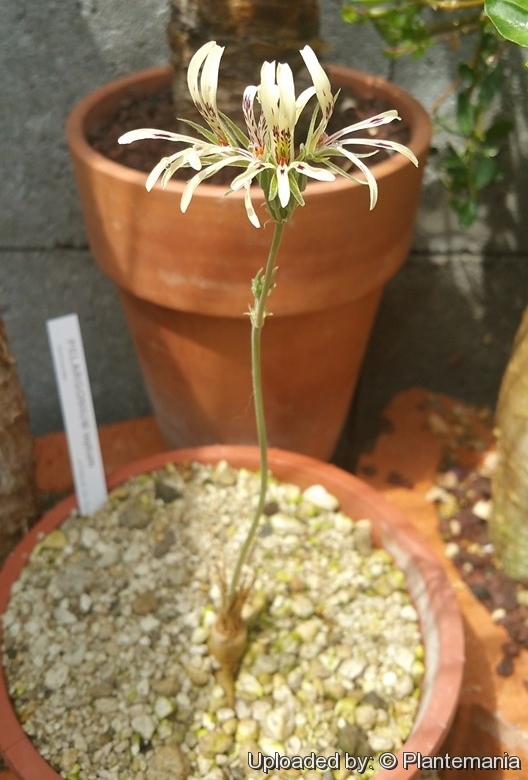




Your support is critical to our success.
- Encyclopedia of SUCCULENTS
- Encyclopedia Index
- Families
- Genera
- Species
- Geraniaceae
- Pelargonium
- Caudiciforms
Since 4 Aug 2013

Origin and Habitat: South Africa, Western Cape (Olifants River Valley to Cape Flats). Pelargonium leptumSN|33654]]SN|33654]] is a naturally rare species known from less than five locations. Subpopulations are small, consisting of only a few scattered adult individuals and are potentially threatened by illegal collecting.
Habitat and Ecology: Fynbos. This species grows in pockets of shallow, sandy soil on the edges of sheets of exposed rocks in winter rainfall areas (precipitation 400-600 mm per annum). This attractive species is not easy to cultivate and therefore potentially threatened by removal of wild plants for the horticultural trade.
Synonyms:
- Pelargonium leptum L. Bolus
Description: Introduced 1928 Pelargonium leptumSN|33654]]SN|33654]], is a small geophyte with turnip shaped roots. The leaves are large, variable and simple in the youth stage in which they are already floriferous, but after several years they becomes very finely divided. The long petalled flowers are cream coloured.
Rootstock: Elongate 50-90 mm long and and 10-35 mm in diameter.
Leaves. Juvenile simple, older irregularly pinnate or twice-pinnately dissected, green, petiolate. Simple leaves oval, 20-40 mm long, 8-20 mm large. Pinnate leave irregular roundisch or triangular in outline, 70-210 long, 70-190 mm wide, leaflets (pinnae) linear10-110 mm long, 1-4 (10) mm wide, sheet pubescent on both sides with sparse long rigid hairs. Petiole 25-210 mm long and 0.5-2 mm in diameter, firm, erect, glabrous or rarely pubescent or hairy. Stipules subulate, fused with petioles to half of their length, 10-50 mm long and 1-2 mm wide, pubescent or ciliate.
Inflorescence: Flowering shoots 50-150 mm long, 1.5-2.5 mm in diameter, branched, with 3-7 branched with 6-12 flowers. Peduncle length of 55-110 mm,1-2 mm in diameter, densely hairy with curly hairs. Bracts subulate, 3-5 mm long, 1-2 mm wide. Hypanthium length 12-30 mm long, hairy same as on the stalk . Sepals 5, lanceolate, apex rounded, 9-12 mm long, 1-3 mm, twisted, green with lighter edge, pubescent above. Petals creamy white to ivory. The upper petals ( ca. 28 mm long, 2-mm wide) are often and streaked with feathery red, reddish-brown or dark purple lines, thin at the base, apex rounded or blunt. The lower petals are slightly smaller (18-26 mm long, 1 , 5-2 mm wide) with wine-red stripe in the centre, thin at the base, apex rounded or blunt. Stamens: staminate column 0.8-2.5 mm long, white; stamens 5, 2.5-6.5 mm long, white. Staminodes 1.5-3 mm long. Anthers red, 1.5 mm long, pollen orange. Ovary 2.2 mm tall; Pistil 0,2-1 mm long, white; stigma branched, 0.5-1 mm long and pink.
Fruits (mericarp): 4 mm long with 20-25 mm long tails.
Bibliography: Major references and further lectures
1) Helme, N.A. & Raimondo, D. 2007. “Pelargonium leptum” L.Bolus. National Assessment: Red List of South African Plants version 2015.1. Accessed on 2017/01/28
2) Craib, C. 2001. “Geophytic Pelargoniums”. Umdaus Press, Hatfield.
3) Marais, E.M. 1994. “Taxonomic studies in Pelargonium, section Hoarea (Geraniaceae)”. Unpublished Ph.D. Thesis, University of Stellenbosch, Stellenbosch.
4) Domitilla Raimondo “Red list of South African plants 2009” South African National Biodiversity Institute, 2009
5) E M Marais “Taxonomic studies in Pelargonium, section Hoarea (Geramaceae) dissertation University of Stellenbosch” 1994
Cultivation and Propagation: Pelargonium leptumSN|33654]]SN|33654]] grows on winter rain and heads for summer dormancy. The growing season in northern hemisphere is from September to March. Paying attention to the particular growing requirement of this species is especially important. If you provide it with the right conditions, it will reward you with its unique shape and size. However, this is a tricky plant that is very particular about its growing conditions and require the right maintenance in order to keep happy.
Soil: It does best with a mix that has almost no organic material at all. Perlite can be substituted for pumice, but it tends to rise to the surface of the mixture. It can grows outdoor in sunny, dry, rock crevices (protection against winter wet is required).
Repotting: Avoid to repot frequently. This plant may stay in the same pot for many years.
Fertilization: Be careful not to apply too much fertilizer. Feed it once during the growing season with a fertilizer specifically formulated for cactus and succulents (poor in nitrogen), including all micro nutrients and trace elements diluted to ½ the strength recommended on the label. It thrives in poor soils and need a limited supplies of fertilizer to avoid the plants developing excess vegetation, which is easily attacked by fungal diseases. Ensure a very good ventilation.
Watering: Water from early February to late April, then from early August to late November, at a minimum temperature of +14° C. Keep completely dry in summer and winter, at a minimum temperature of +8° C. In cultivation it is usually so overwatered and overfertilized that it is hardly recognizable as the species that it is. Correctly grown, this is a beautiful, compact and dense plant.
Hardiness: Protect from frost.
Exposure: Light shade or morning sun in summer (avoid direct sun as it grows wild among rocks and under the shade of other plants) and in summer it need to be kept in a cool area.
Reproduction: Pelargonium leptumSN|33654]]SN|33654]] can be propagated from seed or dividing the tubers. Plant seeds any time of the year, but a spring or autumn sowing of seeds is usually most successful. Seeds need cool temperature to sprout. Rooting cuttings of stems is another method. Germination can be very erratic, and can take place over a long period of time. There is a way of overcoming the long time periods and the inhibitors; that is, by scarifying the seeds.
| Your Actions | |
|---|---|
| Back to Pelargonium index | |
| Back to Geraniaceae index | |
 |
Back to Succulents Encyclopedia index |
Privacy stantement - Terms and conditions - How to cite - About us - Feedback - Donate



